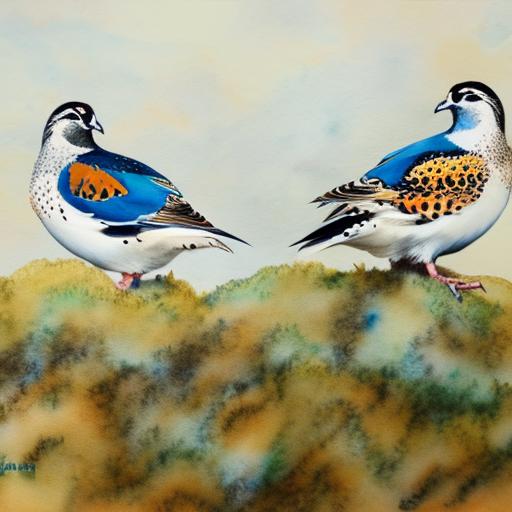Quails are small, ground-dwelling birds that are popular for their delicious eggs and tender meat. There are several different breeds of quail, each with its own unique characteristics and traits. Some of the most popular quail breeds include the Coturnix quail, Bobwhite quail, Gambel’s quail, and California quail. Each breed has its own distinct size, coloration, and egg-laying capabilities. For example, the Coturnix quail is known for its prolific egg-laying abilities, while the Bobwhite quail is prized for its flavorful meat. Understanding the different breeds of quail is important when considering mixing them, as each breed has its own specific needs and requirements.
Quail breeds also vary in terms of their temperament and behavior. Some breeds may be more docile and easy to handle, while others may be more skittish and flighty. It’s important to consider the temperament of each breed when deciding which ones to mix, as certain combinations may not be compatible. Additionally, different quail breeds have different housing and environmental requirements, so it’s important to take these factors into account when mixing breeds. Overall, understanding the unique characteristics and traits of each quail breed is essential for successfully mixing them.
Key Takeaways
- There are various quail breeds, each with unique characteristics and traits
- Factors to consider when mixing quail breeds include size, temperament, and egg production
- Mixing quail breeds can result in hybrid vigor, increased genetic diversity, and unique color patterns
- Potential challenges of mixing quail breeds include aggression, mating issues, and difficulty in maintaining breed purity
- Tips for successfully mixing quail breeds include providing adequate space, monitoring behavior, and separating aggressive birds
- Popular quail breeds for mixing include Coturnix, Bobwhite, and California Valley
- Whether mixing quail breeds is right for you depends on your goals, resources, and willingness to manage potential challenges
Factors to Consider When Mixing Quail Breeds
When it comes to mixing quail breeds, there are several important factors to consider. One of the most important factors is compatibility. Not all quail breeds are compatible with each other, and some combinations may result in aggression or fighting. It’s important to research the temperament and behavior of each breed before mixing them to ensure that they will get along well. Additionally, it’s important to consider the size and weight differences between breeds, as larger breeds may bully or intimidate smaller ones.
Another important factor to consider when mixing quail breeds is the purpose of mixing. Are you mixing breeds for egg production, meat production, or simply for aesthetic purposes? Different breeds have different strengths and weaknesses when it comes to egg-laying capabilities and meat quality, so it’s important to consider your goals when mixing breeds. Additionally, it’s important to consider the housing and environmental requirements of each breed when mixing them. Some breeds may have specific temperature or humidity needs, so it’s important to ensure that these requirements can be met for all the breeds you plan to mix.
Benefits of Mixing Quail Breeds
There are several benefits to mixing quail breeds. One of the main benefits is genetic diversity. By mixing different quail breeds, you can introduce genetic diversity into your flock, which can lead to healthier and more robust birds. Genetic diversity can also lead to increased resistance to diseases and parasites, as well as improved overall vitality. Additionally, mixing quail breeds can lead to hybrid vigor, which can result in increased egg production and better meat quality.
Another benefit of mixing quail breeds is the potential for unique coloration and patterns. By mixing different breeds, you can create visually stunning birds with a wide range of colors and patterns. This can be especially appealing for hobbyists and enthusiasts who are interested in creating unique and beautiful flocks of quail. Additionally, mixing quail breeds can lead to a more interesting and diverse flock overall, which can be enjoyable for both hobbyists and commercial producers alike.
Potential Challenges of Mixing Quail Breeds
While there are many benefits to mixing quail breeds, there are also potential challenges to consider. One of the main challenges is aggression and fighting between different breeds. Not all quail breeds are compatible with each other, and some combinations may result in aggression or bullying. This can lead to injuries and stress among the birds, as well as decreased egg production and meat quality. It’s important to carefully monitor the behavior of mixed flocks and be prepared to separate birds if necessary.
Another potential challenge of mixing quail breeds is the risk of creating undesirable hybrids. While hybrid vigor can be a benefit of mixing breeds, it’s also possible to create hybrids with undesirable traits or characteristics. This can be especially problematic for commercial producers who are looking for consistent egg production and meat quality. Additionally, some mixed breeds may not meet breed standards or may be ineligible for exhibition or competition purposes. It’s important to carefully consider the potential outcomes of mixing quail breeds before proceeding.
Tips for Successfully Mixing Quail Breeds
To successfully mix quail breeds, there are several tips to keep in mind. First, it’s important to research the temperament and behavior of each breed before mixing them. Not all quail breeds are compatible with each other, so it’s important to choose breeds that are known for being docile and non-aggressive. Additionally, it’s important to provide plenty of space and hiding spots for mixed flocks to reduce aggression and bullying.
Another tip for successfully mixing quail breeds is to carefully monitor the behavior of mixed flocks. It’s important to observe the birds regularly to ensure that they are getting along well and not exhibiting any signs of aggression or stress. If any issues arise, it’s important to be prepared to separate birds if necessary to prevent injuries or fighting. Additionally, it’s important to provide a balanced diet and proper nutrition for mixed flocks to ensure their health and vitality.
Popular Quail Breeds for Mixing

There are several popular quail breeds that are commonly mixed for various purposes. One of the most popular quail breeds for mixing is the Coturnix quail, which is known for its prolific egg-laying abilities and gentle temperament. Coturnix quails come in a variety of colors, including tuxedo, golden, and silver, making them a popular choice for creating visually stunning mixed flocks. Another popular quail breed for mixing is the Bobwhite quail, which is prized for its flavorful meat and attractive appearance.
In addition to Coturnix and Bobwhite quails, other popular quail breeds for mixing include Gambel’s quails and California quails. Gambel’s quails are known for their striking plumage and distinctive topknots, making them a popular choice for creating visually interesting mixed flocks. California quails are known for their sociable nature and attractive appearance, making them a popular choice for hobbyists and enthusiasts looking to create diverse flocks of quail.
Is Mixing Quail Breeds Right for You?
In conclusion, mixing quail breeds can be a rewarding endeavor that offers many benefits, such as genetic diversity, hybrid vigor, and unique coloration and patterns. However, it’s important to carefully consider the potential challenges and risks associated with mixing breeds, such as aggression, undesirable hybrids, and compatibility issues. By researching the temperament and behavior of each breed, providing proper housing and nutrition, and carefully monitoring mixed flocks, it is possible to successfully mix quail breeds.
Ultimately, whether mixing quail breeds is right for you will depend on your goals and preferences as a quail owner. If you are interested in creating visually stunning flocks with unique coloration and patterns, or if you are looking to introduce genetic diversity into your flock, then mixing quail breeds may be a good option for you. However, if you are primarily focused on consistent egg production or meat quality, or if you are concerned about potential compatibility issues or aggression between mixed breeds, then it may be best to stick with a single breed. Regardless of your decision, it’s important to prioritize the health and well-being of your quail flocks above all else.
Sure, here’s the paragraph with the related article included as an tag:
When considering mixing quail breeds, it’s important to understand the potential challenges and benefits. In a recent article on PoultryWizard.com, “The Pros and Cons of Mixing Quail Breeds” explores the various factors to consider when combining different quail varieties in a single flock. Understanding the implications of crossbreeding and the impact on egg production and temperament can help poultry enthusiasts make informed decisions. For more insights on poultry management, check out PoultryWizard’s article on large chicken coop ideas.
FAQs
What are quail breeds?
Quail breeds refer to the different varieties or types of quail that exist, each with its own unique characteristics such as size, color, and egg production.
Can you mix different quail breeds together?
Yes, it is possible to mix different quail breeds together. However, it is important to consider factors such as size, temperament, and purpose (e.g., egg production or meat) when mixing quail breeds.
What are the potential outcomes of mixing quail breeds?
When mixing quail breeds, the resulting offspring may exhibit a combination of traits from the parent breeds. This can lead to variations in size, color, and egg production among the mixed breed quail.
Are there any considerations to keep in mind when mixing quail breeds?
It is important to consider the potential for aggression or mating difficulties when mixing quail breeds. Additionally, if breeding for specific traits, it is important to carefully select the parent quail to achieve the desired outcomes in the offspring.
Meet Walter, the feathered-friend fanatic of Florida! Nestled in the sunshine state, Walter struts through life with his feathered companions, clucking his way to happiness. With a coop that’s fancier than a five-star hotel, he’s the Don Juan of the chicken world. When he’s not teaching his hens to do the cha-cha, you’ll find him in a heated debate with his prized rooster, Sir Clucks-a-Lot. Walter’s poultry passion is no yolk; he’s the sunny-side-up guy you never knew you needed in your flock of friends!







